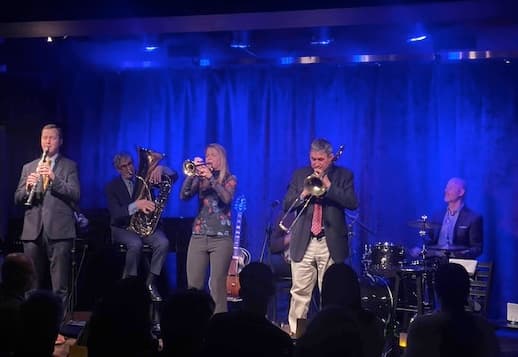The Spirit of a Long-Departed Legend, Louis Armstrong, Lives Strong at Birdland
Now launching its 24th year of playing at Birdland, the Louis Armstrong Eternity Band is the creation of the tuba player, bandleader, former attorney, and passionately devoted Armstrong scholar, David Ostwald.

Louis Armstrong Eternity Band
Wednesdays at Birdland
Manhattan
Listening to the Louis Armstrong Eternity Band at Birdland this past Wednesday, I realized something I had never thought about before: It’s kind of amazing that Louis Armstrong used “When It’s Sleepy Time Down South” as his theme song — and that he opened thousands of concerts, radio broadcasts, and other performances with it. Armstrong was among the most exciting performers in the entirety of music and showbiz, and yet always started by “crooning soft and low” this sentimental song whose stated purpose was to put everybody to sleep.
Small wonder that Armstrong would immediately follow it with “Back Home Again in Indiana,” which was also a nostalgic old song, vintage 1917, well before Armstrong ever played it; in the wrong hands, it could be rather maudlin, so Armstrong made a point to jam it, to play it fast and furious, and to make it into something thrilling rather than sleep-inducing. In a sense, he would start with two songs about going home — one to the South, the other to the Midwest, one sweet and tender, the other just the opposite. Without necessarily even trying to, he had tapped into everybody’s complicated relationship with where we come from, and our collective feelings about what home means.
Armstrong used “Sleepy Time” as his theme for almost 40 years; the Louis Armstrong Eternity Band has opened each show with the “Sleepy Time” / “Indiana” sequence every Wednesday at Birdland for more than half that time. Now launching its 24th year of playing at Birdland, the group is the creation of the tuba player, bandleader, former attorney, and passionately devoted Armstrong scholar, David Ostwald.
The current lineup of the LAEB is an especially strong one: The front line is trumpeter Bria Skonberg, trombonist Jim Fryer, and Will Anderson, clarinet and saxophone; Mr. Ostwald plays his tuba in its traditional function as a brass bass, and he’s joined in the rhythm section by Arnt Arnzen on guitar and banjo and drummer Paul Wells. Nearly all have been regular members of Vince Giordano’s Nighthawks at some point.
In addition to all of his other achievements, which can only be captured by multiple books (the ultimate Armstrong biographer, Ricky Riccardi, the Caro of Satchmo, is finishing his third volume), Armstrong perfected the notion of the singing instrumentalist. Appropriately, nearly every member of this band sings several times per show.
Ms. Skonberg, who plays with the force of Armstrong and sings with a softness more reminiscent of Peggy Lee (herself an Armstrong fan, she sang at his funeral), covered “I’ll Never Be The Same,” which both Billie Holiday and Sinatra learned from Pops, and “There’ll Be Some Changes Made.” Mr. Arntzen crooned sweetly on “Home,” which Nat King Cole learned from Armstrong, and “I’ll See You In My Dreams.” Mr. Fryer, singing with a voice that somehow reminds me of the British trad jazz star Kenny Ball, marched us through “Cake Walking Babies from Home.” Mr. Anderson essayed “I Got It Bad (And That Ain’t Good)” on alto, summoning Johnny Hodges, but by playing it in 2/4, illuminating Hodges’s own roots in Sidney Bechet.
These six musicians have been together long enough to have worked out numerous clever routines in terms of chase choruses and conjoined solos. On “I’ll See You In My Dreams,” Mr. Fryer switches to euphonium and joins Mr. Ostwald and his tuba in a duet of low-hanging brass. On “I’ll Never Be the same,” the clarinet and trombone split a chorus, and on “Swing That Music,” Messrs. Fryer and Arnzen trade lyric lines back and forth.
The wildest piece here illustrated what might be deemed the avant-garde side of Satch: the 1926 “King of the Zulus,” named after a Mardi Gras fraternal organization in New Orleans and credited to Armstrong’s wife, pianist Lil Hardin. The piece was popular enough for one of Armstrong’s occasional employers, Clarence Williams, to record what can only be called a “cover” version four months later, and for Pops himself to recreate it 30 years later on his “Musical Autobiography.” Mr. Ostwald and company omitted the comedy dialog section and concentrated on the tune itself, with Ms. Skonberg growling through a cup mute. Although named after a parade march, this is more of a sultry slow dance, a darkly minor piece that directly prefigures slightly later works by Duke Ellington, like “The Mooche” and “Black and Tan Fantasy.”
Nearing the conclusion, Mr. Ostwald, who serves as a witty and irreverent host throughout, brought us home with the 1931 “Home,” which Armstrong returned to in 1957. The band then concluded with its familiar closer, “Swing That Music,” which built to a climactic drum solo by Mr. Wells. Armstrong split the scene more than 50 years ago, but he’d be glad to know that his spirit is still with us, and still serving what he so aptly called “the cause of happiness.”

